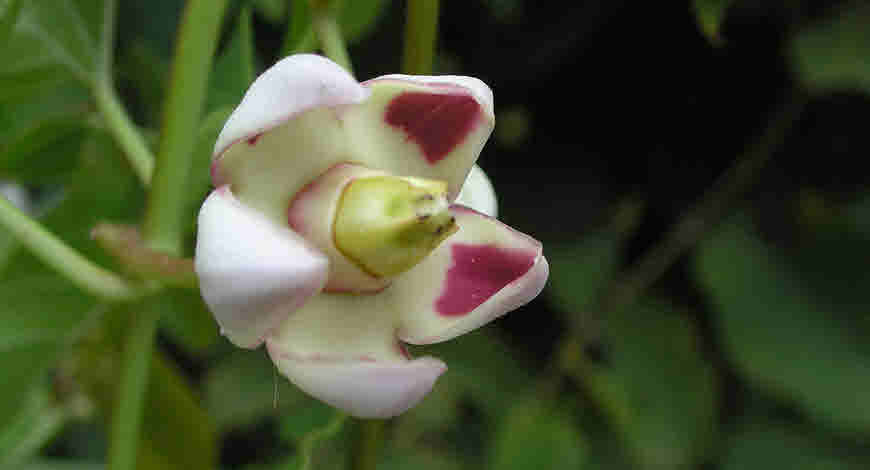Jivanti is an important medicinal plant used in Ayurveda. The mention of Jivanti is even found in Atharva Veda. Charak and Bhavprakash, describe it as best among leafy vegetables. It is included in Jivaniya Gana, which is the group of herbs used for promoting vitality and life.

Jivanti is considered a stimulant and tonic in Ayurvedic literatures. It is indicated in debility due to seminal discharge. It is described as an herb with sweet, cold, aphrodisiac, light to digest and rejuvenative properties. It enhances life, vigor and fertility. Jivanti is tridosh-har and balances Vata, Pitta, and Kapha. This is drug of choice for emaciation, weakness, fever, difficult breathing, burning sensation in the body, and fertility issues.
Though it is an important herb but the botanical identity of this plant is highly disputed.
Nowadays, there are many plants which are used as Jivanti.
In Bhavprakash, Dregea volubilis (Synonyms Marsdenia volubilis (L.f.) Cooke., Wattakaka volubilis (L.f.) Stapf.) is described as Jivanti. In Sanskrit this plant is known as Hema, Hemavati, Hemalatha, Swarnika, Swarnalatha, Hemajivanti, Swarna jivanti.
This plant is found growing in moist places. It is a large woody twining perennial shrub belonging to family Apocynaceae. It has pale green flowers in dense drooping umbels. It is a medicinal plant and used as emetic, diaphoretic and diuretic.
In Bengal, Bihar, and Uttar Pradesh, Dendrobium macraei Lindl., Synonym Flickingeria macraei (Lindl.) Seidenf., belonging to Orchid family is available as Jivanti. The whole dried plant is used as Jivanti. The Panchang is yellow in color and known as Swarn Jivanti.
In Gujrat, Leptadaenia reticulata is used as Jivanti. It is grown as pot herb and used to treat diseases of eyes and tuberculosis. Leptadaenia reticulata is used as Jivanti in preparation of many Ayurvedic medicines. This drug is accepted as real Jivanti by many.
In Southern part of India, the roots of the plant, Holostemma Annularis Synonym Holostemma ada-kodien is used as Jivanti / Jivanthi. This page is about the medicinal plant Holostemma Annularis, which is used as Jivanthi in Kerala.
Jivanthi or Annular Holostemma is famous Ayurvedic medicinal herb. In India, Annular holostemma is found in Tropical Himalayas and Western Peninsula. It is mainly cultivated in Dharmapuri district of Tamil Nadu.
Jivanthi is also known as Ark pushpi in Ayurveda and Palaykeerai in Siddha system of medicine. This medicinal herb is perennial twining shrub that secrets milky latex. The leaves are ovate and flowers are fleshy pinkishred. The propagation of the plant are through seeds and vegetative methods.
General Information
Holostemma ada-kodien is a perennial, laticiferous, twinning, shrub with large flowers and reddish stem. Stem is branches glabrous and shining. The leaf is simple, opposite, large, and deeply cordate at base. Flower is purple in axillary, umbellate cymes. Calyx are deeply five partite, Corolla is Gamopetalous (having the petals united) and deeply five lobed, pinkish outside and purplish inside. Fruits are thick, follicle, cylindrical and bluntly pointed containing numerous flattened cosmose seeds.
The roots of the plant are hairy, pretty long up to a meter or more, yellowish-brown and cylindrical. Fresh roots have a sweetish, starchy taste. On drying, it is yellow brown to brownish black. The cross section of dried root is white color with few grew streaks.
It is widely distributed in tropical rain forests of the world.
Scientific Classification
The botanical name of Holostemma / Jeevanthi is Holostemma adakodien. It belongs to plant family Apocynaceae (Dogbane family), consisting mainly of trees, shrubs, herbs, stem succulents, and vines. The family Asclepiadaceae (now known as Asclepiadoideae) is considered a subfamily of Apocynaceae and contains 348 genera.
Below is given taxonomical classification of the plant.
- Kingdom: Plantae
- Phylum: Tracheophyta
- Class: Magnoliopsida
- Order: Gentianales
- Family: Apocynaceae
- Genus: Holostemma
- Latin name: Holostemma annularis (Roxb.) K. Schum.
Synonym:
- Holostemma adakodien Schult.
- Holostemma rheedii Wall.
- Asclepias annularis Roxb.
Part(s) used for medicinal purpose: roots, leaves, latex, flower
Plant type: twinning, shrub
Distribution: Tropical Himalayan region, Dehradun, Western Ghats up to an altitude of 2000 m. Also found in Sri Lanka, Myanmar and Western China.
Habitat: moist deciduous forests, scrub jungles and foot hills of the dry deciduous forests
Constituents of Holostemma adakodien
Tubers / roots, contains 4.07% protein, 24 % sugar and 35.4% starch. The roots also contain α – amyrin, lupeol, β – sitosterol and Six Amino Acids – alanine, aspartic acid, threonine, glycine, serine and valine.
Vernacular names/Synonyms
- Ayurvedic: Ark-pushpi
- Siddha: Palay-keerai
- Hindi: Chirvel
- Gujarati: Kharner, Khiravel, Khordodi; Kannada: Jeeva haaleballi, Muraligana kasa
- Malayalam: Adakodien, Atakkoti
- Marathi: Shidodi
- Telugu: Palagurugu, Dudidapalatiga, Bandiguruvinda teega
- Trade name: Ringcoronel, Swallowwort
- English: Holostemma
Medicinal use of Annular Holostemma (Holostemma ada-kodien)
Holostemma ada-kodien, is found in tropical Western Ghats. It is used in as a tonic that maintains youthful vigour. The tuberous roots of the plant are used to treat eye diseases, cough, fever, burning sensation and as a galactagogue.
- The roots have cooling, alterative, tonic and laxative properties. They are used as Tonic, laxative, aphrodisiac, expectorant, ophthalmic, emollient, Tonic, stimulant, and galactagogue.
- The roots are used in labor and lactation.
- The root paste is applied in eye inflammation and orchitis (inflammation of the testes).
- The juice of root is given in spleen enlargement.
- Root is also useful in the treatment of diabetes, gonorrhea, coughs and stomachache.
- The leaves, flowers and fruits are eaten as vegetable.
- The milky Latex of the plant are applied to heal ulcers and wounds.
- The decoction of the plant has galactagogue effect and is useful in inducing lactation.
- The flowers of the plant are also edible and given for treating sexually transmitted infections.